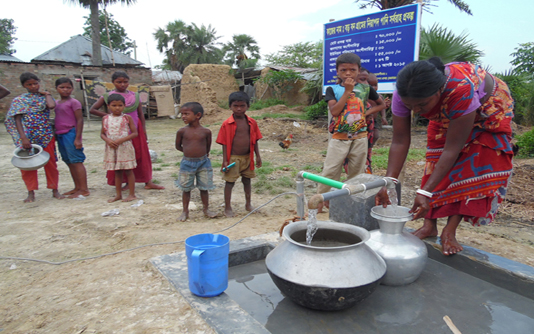RAJSHAHI, Oct 20, 2018 (BSS) – Kostantina Hashda, 43, wife of Mathius
Hembrom of Nobaibottola village under Godagri upazila in the district, has
started getting access to safe drinking water after a long wait.
“We had to face multifarious problems relating to fetching water for our
five-member family,” said Kostantina while talking to BSS here Friday adding
that the problem has now been eradicated.
Bimola Saren, 32, wife of Sukhen Saren, also expressed her happiness over
the water supply system. She is now getting requisite water for her seven-
member family.
A submersible pump has been installed in the locality and water is being
supplied to the households through commissioning pipeline and outlets
ensuring water rights to the drought-affected Barind area.
Like Kostantina, 1.45 lakh families including 1.02 lakh ethnic minority
people have been brought under safe drinking water source through
commissioning 298 submersible pumps in the high Barind tract.
The pumps along with 97,315 feet pipelines were commissioned with
intervention of ‘Integrated Water Resource Management (IWRM) project’ being
implemented in 35 UPs and three pourasabhas in Rajshahi, Naogaon and
Chapainawabganj districts since 2014.
DASCOH Foundation and Swiss Red Cross are jointly implementing the project
with financial support from Swiss Agency for Development and Cooperation-SDC.
The beneficiary people took the responsibility of proper maintenance and
function of the infrastructures routinely. The initiative has been taken to
maintain round-the-year drinking water supply to the poor and vulnerable
villagers, where, power supply is available.
Two solar panels were installed to operate two pumps in the villages
remain beyond power supply network.
Ataur Rahman, chairman of Badhair Union Parishad under Tanore upazila,
said the water-deprived poor and underprivileged communities in the drought-
hit area are getting safe drinking water privileges with the project
intervention.
In the wake of inadequate aquifer recharge, groundwater level is declining
alarmingly in the high Barind tract posing a serious threat to its farming
sector besides living and livelihood condition of the poor and marginalized
population including the ethnic minorities.
Lifting underground water through deep tube-wells is becoming tougher
during the dry season day by day. Options for surface water are also very
limited.
He, however, said that the submersible water supply system has become a
blessing for the drought-affected people.
Akramul Haque, chief executive officer of DASCOH Foundation, said the
scheme intends to supply safe drinking water in those drought-prone areas
where acute crisis of drinking water exists.
Its main objective is to supply round-the-year potable water to all people
in the targeted area. “We have undertaken another initiative of supplying
safe drinking water to 5,400 other drought-hit people of 1,200 households at
Bidirpur village under Godagari upazila,” he added.
Installation of a deep tube-well along with an overhead tank is progressing
fast for the purpose. “We are installing 6,000-meter pipelines for supplying
door-to-door water like urban areas,” he added.
Prof Chowdhury Sarwar Jahan of Department of Geology and Mining of Rajshahi
University says the initiative contributes a lot to reduce the acute crisis
of drinking water in the drought-prone Barind area.
Referring to his research findings, he said there is a shortage of drinking
water in the region during dry season and the problem has become acute for
the last couple of years.
The existing shallow water technologies become ineffective currently and
demand for deep tube-wells has increased in the area due to rapid decline of
groundwater level along with arsenic contamination in shallow aquifer in many
areas.
Dr Chowdhury said villagers cannot withdraw groundwater as the water level
goes down abnormally during every dry season.
He said the excessive use of groundwater through irrigation and the
existing adverse impact of climate change are putting local people into
trouble since the hand-driven tube-wells are not functioning here in dry
season.
The changed climatic condition has been posing a serious threat to the
overall public health in the vast Barind tract, especially Tanore and
Godagari upazilas in Rajshahi and Nachole and Gomostapur upazilas in
Chapainawabganj.
“The fight against water scarcity and unhygienic situation is very tough.
Coordinated efforts of different government and non-government organisations
are needed to address water problems here,” Dr Chowdhury added.



